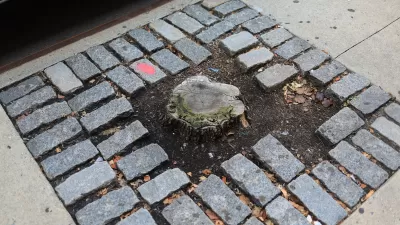Tree planting is a highly visible way to show investment in a community, but without regular maintenance, street trees can become a nuisance rather than a benefit.

An associate professor at North Carolina State University is delving into the long-term impacts of tree planting efforts. Ysabelle Kempe explains: “Smart Cities Dive caught up with Larson to discuss the potential worst outcome of tree-planting efforts, whether trees are inherently valuable to society and why communities in most need of trees may not welcome more.”
Larson points out that “you can’t just put a tree in the ground. You have to nurture it, you have to care for it and maintain it.” Larson explains that, if left unattended, urban trees can quickly die off. Meanwhile, trees, usually viewed as a universal good, can also have negative impacts on communities. “They’re a maintenance issue. They create opportunities for perceived crime in densely forested settings. Sometimes trees fuel property [value] rises and [higher] property taxes, which is a good thing, but it also can catalyze green gentrification, which drives residents out of neighborhoods where they might have been for generations.”
Larson says one obvious solution is “don’t plant trees without public input and community involvement.” For planners or advocates hoping to start tree planting projects, Larson advises, “Take a little bit of time to get to know the place, the key players, and work within their system and the organizations that are based there to make things happen.”
FULL STORY: “Dead trees all over the city”: Where tree-planting efforts go wrong

Alabama: Trump Terminates Settlements for Black Communities Harmed By Raw Sewage
Trump deemed the landmark civil rights agreement “illegal DEI and environmental justice policy.”

Planetizen Federal Action Tracker
A weekly monitor of how Trump’s orders and actions are impacting planners and planning in America.

The 120 Year Old Tiny Home Villages That Sheltered San Francisco’s Earthquake Refugees
More than a century ago, San Francisco mobilized to house thousands of residents displaced by the 1906 earthquake. Could their strategy offer a model for the present?

In Both Crashes and Crime, Public Transportation is Far Safer than Driving
Contrary to popular assumptions, public transportation has far lower crash and crime rates than automobile travel. For safer communities, improve and encourage transit travel.

Report: Zoning Reforms Should Complement Nashville’s Ambitious Transit Plan
Without reform, restrictive zoning codes will limit the impact of the city’s planned transit expansion and could exclude some of the residents who depend on transit the most.

Judge Orders Release of Frozen IRA, IIJA Funding
The decision is a victory for environmental groups who charged that freezing funds for critical infrastructure and disaster response programs caused “real and irreparable harm” to communities.
Urban Design for Planners 1: Software Tools
This six-course series explores essential urban design concepts using open source software and equips planners with the tools they need to participate fully in the urban design process.
Planning for Universal Design
Learn the tools for implementing Universal Design in planning regulations.
Clanton & Associates, Inc.
Jessamine County Fiscal Court
Institute for Housing and Urban Development Studies (IHS)
City of Grandview
Harvard GSD Executive Education
Toledo-Lucas County Plan Commissions
Salt Lake City
NYU Wagner Graduate School of Public Service





























